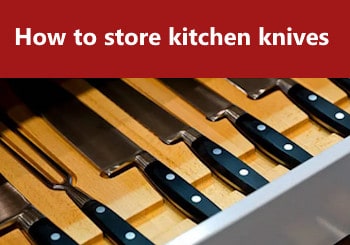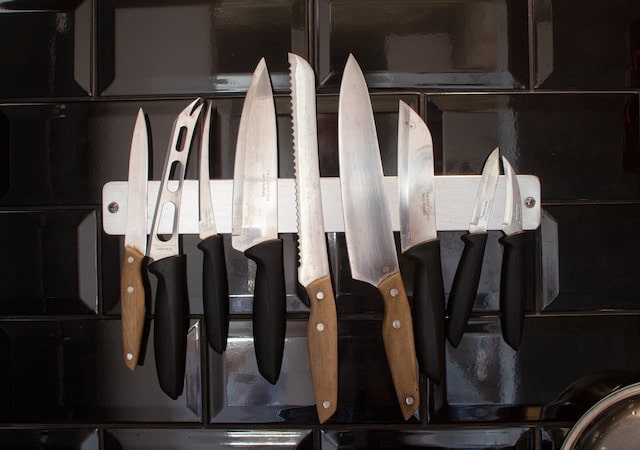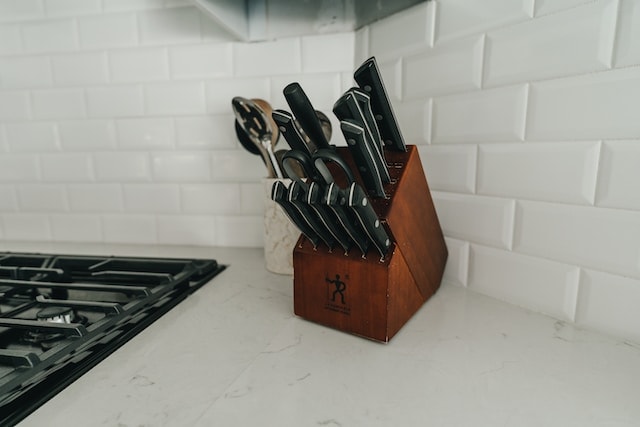How to Store Kitchen Knives
| Mini guides to kitchen knives: Kinds of kitchen knives | Materials and construction | Storing | Sharpening | Maintaining sharpness | Rust removal | Disposal | Knife skills | Western or Japanese knives | Main kitchen knife guide |

Understanding and knowing how to store kitchen knives properly is crucial for maintaining their sharpness, ensuring safety, and prolonging their lifespan.
By selecting the right storage solution, from knife blocks and magnetic strips to in-drawer trays, one can optimise kitchen space, prevent accidents, and keep knives easily accessible for everyday cutting tasks.
Proper storage also protects the knife blade from unnecessary wear and tear, making your kitchen knives more efficient and reliable.
How to store kitchen knives without a block
A kitchen knife block allows you to display and store your knives easily and safely, however there are many other ways to store knives without a block. In fact, what you choose may depend on what the kitchen knives are made of.
Let’s look at 3 alternative ways to store your kitchen knives without a block.
1. Magnetic knife rack
The most practical option for us is a magnetic knife rack or strip. Such a rack mounts onto a wall close to your kitchen workspace for easy access, and as the knives are held in a flat row next to each other.
Always choose a good quality rack with a strong magnet so your knives do not fall off the rack accidentally. Best of all, a magnetic rack means you aren’t utilising counter space or drawer space.

2. Drawer knife blocks
These are made for simple organisation and because they have individual slots for the knife blades the knives are also well protected.
3. Knife sheaths
Knife sheaths or edge guards are for individual use and protect the blades too. It is a great way to store knives in a drawer and avoid bluntness.
Knife Storage Solutions Comparison Table
| Knife Storage Solution | Pros | Cons |
|---|---|---|
| In-Drawer Knife Block |
|
Limited drawer space for many knives |
| Magnetic Knife Holder Strip |
|
|
| Leather Knife Roll |
|
Inconvenient access in the kitchen Limited storage for a large set of knives |
| Slotless Knife Block |
|
|
| Magnetic Knife Block |
|
|
Where to put knives in the kitchen
Storing knives correctly and in a safe way is important but there are a few other things to consider when working with knives.
- Cleanliness and hygiene is the highest on our list of priorities and that is why we recommend the magnetic strip or knife sheath. Wooden knife blocks may get mouldy if not treated correctly or if knives are not dried properly before placing them into the block.
- Convenience is another important point. Again, we like the magnetic strip as they keep the countertop free and the knives are within reach.
- Features might also impact your choice. Some knife blocks come with sharpening tools.
- When storing a knife, always rest it on the side to avoid dull blades.
How to display knives in the kitchen
As knives are essential in the kitchen, why not display them so they are aesthetically appealing. There are a few ways to do so:
- The magnetic strip exists in various materials, such as wood or stainless steel, to match any kitchen style.
- The knife block is a good and safe way to display knives, but the downside is that it takes counter space.
- Open shelving with knife slots is another way to showcase knives and create an open and visually appealing display.

How to lock up kitchen knives
Whether it’s to keep children from touching them or to keep them in a safe place when not in use, there are a few ways to lock up kitchen knives.
Here are 5 suggestions to keep your kitchen knives locked and away from prying hands.
1. A drawer or cabinet with lock
This is the cheapest way to lock up knives. A traditional key lock should be sufficient but there are also digital locks for extra security.
2. A knife safe
It’s in the name, this safe or lockbox is dedicated and designed specifically for securing knives.
3. Magnetic knife rack with lock cover
Some brands design magnetic knife racks with a cover that can be locked so the knives are only accessible when the cover is unlocked.
4. A cable lock
This is another low cost option that can be obtained in hardware stores. Wrap a set of knives in a wire or cable lock and secure them together. Attach it to a cabinet or anything stationary and lock it with a combination or key for access control.
5. A knife block with lock
Some knife blocks have a locking mechanism. They are made of wood or plastic and have slots for different-sized knives. You need the correct code to remove knives from the block.
Summary of locking kitchen knife storage
Locking up kitchen knives is mostly a safety measure to prevent unauthorised access to sharp blades. Here’s a complete summary on how to lock up kitchen knives.| Method | Description |
|---|---|
| Knife Drawer with Lock | Use a drawer with a built-in lock or install a lock to store knives securely. |
| Knife Cabinet with Lock | Invest in a dedicated knife cabinet with a locking mechanism for safe storage. |
| Knife Safe or Lockbox | Use a knife safe or lockbox to secure knives with locks or combination codes. |
| Childproof Locks | Install childproof locks on kitchen cabinets or drawers to prevent access. |
| Wall-Mounted Magnetic Strip with Lock | Add a lockable cover or case to a wall-mounted magnetic strip for knife storage. |
| Locked Kitchen Pantry | Store knives in a locked cabinet or drawer within a secure kitchen pantry. |
| High-Location Storage | Mount a high shelf or use a tall cabinet to store knives out of reach. |
| Keyed Locks or Combination Locks | Secure knives with locks using keys or combinations known to responsible adults. |
When locking up kitchen knives, it’s important to balance safety with convenience. Make sure that the locked storage solution you choose is easily accessible to those who need to use the knives while effectively preventing access by unauthorised individuals.
Always educate household members about the importance of knife safety and the necessity of keeping the knives locked up when not in use.
What are three recommendations for storing knives to help prevent damage and cuts?
1. Use knife guards or blade covers
Investing in knife guards or blade covers for each of your knives can be really helpful for the longevity of your kitchen knives. The protective covers are designed to fit over the blade, keeping it safely enclosed.
The covers not only prevent accidental cuts and injuries, but also protect the blade from getting damaged when stored in a drawer.
2. Store knives separately
To prevent blades from coming into contact with each other and potentially causing damage, store knives separately. Don’t pile them all together touching one another in a drawer or container.
This separation minimises the risk of blades clashing and getting chipped or dulled.
3. Consider a dedicated knife block or magnetic strip
Choose a dedicated knife block or a magnetic knife strip designed specifically for storing knives. These options provide a safe and organized way to store your knives.
A knife block keeps blades protected and ensures they are readily accessible, while a magnetic strip saves counter space and allows for easy identification and retrieval.
How to transport kitchen knives
Travelling with knives needs to be done in a safe way. As we often travel to cook in other places, we have a few tips on how to transport knives safely.
- A knife roll or case
We love this as it is designed specifically for transporting knives There are individual compartments for each knife to fit, from chef’s knife to paring knife. Once the knives are inserted, roll them up and close it tight.
- A thick towel
If you don’t often travel with knives, a thick towel will work the same way as a knife roll. The big difference is that there are no compartments and you have to be extra careful to avoid damaging the knives. Once all knives are safely rolled up into the towel, tie an elastic rubber band around it to hold everything together.
Tips for Transporting Kitchen Knives
| Method | Description |
|---|---|
| Knife Guards or Blade Covers | Use plastic or fabric sleeves to cover the blades for protection. |
| Magnetic Knife Strips or Blocks | Firmly attach knives to magnetic strips or blocks for secure transport. |
| Knife Rolls or Knife Cases | Use dedicated cases with individual slots or pockets for safe transportation. |
| DIY Knife Wrap | Create a wrap using a soft cloth or towel to cover and secure knives. |
| Secure the Blades | Use cardboard, foam, or bubble wrap to protect the blades during transport. |
| Label and Pack Carefully | Label containers to indicate sharp objects, and pack knives securely. |
| Keep Handles Visible | Ensure handles are visible for easy identification and safe handling. |
| Avoid Mixing with Other Items | Transport knives separately from other kitchen tools to prevent damage. |
| Consider Blade Guards | Invest in individual blade guards for extra protection for each knife. |
| Handle with Care | Always handle packaged knives with caution, especially when unpacking or repacking. |
How many kitchen knives do you need?
There are discussions about how many knives you need in a kitchen but we believe that three types are essential.
- A chef’s knife is perfect for all kinds of cutting, slicing, and chopping. Chef’s knives are available in different sizes and the size that fits best in your hand and feels most comfortable to work with is the right one for you!
- A paring knife is a small knife and perfect for delicate cutting tasks and peeling of ingredients such as fruit and certain vegetables.
- A bread knife with a serrated blade is good for cutting through ingredients with a hard crust and a soft interior. Cutting with this knife happens in a ‘sawing’ motion to ensure the product is not squeezed or smashed.
Final note on how to store kitchen knives
The way we store our kitchen knives is as important as how we use them. Proper storage not only safeguards the integrity and sharpness of the blade but also ensures a safer kitchen environment.
By finding the right storage methods, we can extend the life of our knives, keep our family safe, and maintain a clutter-free kitchen.